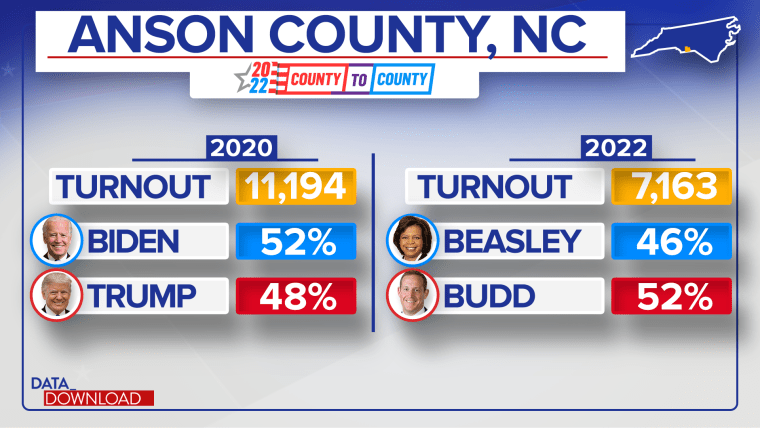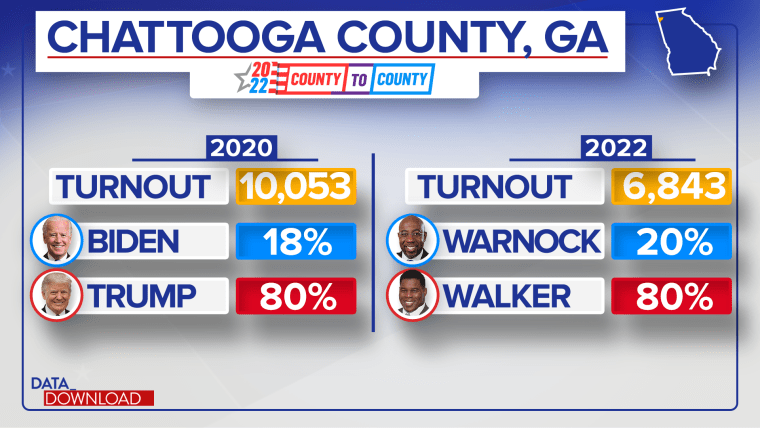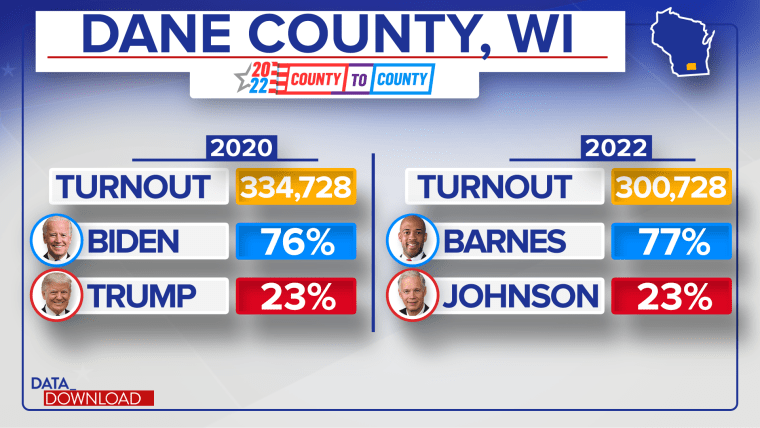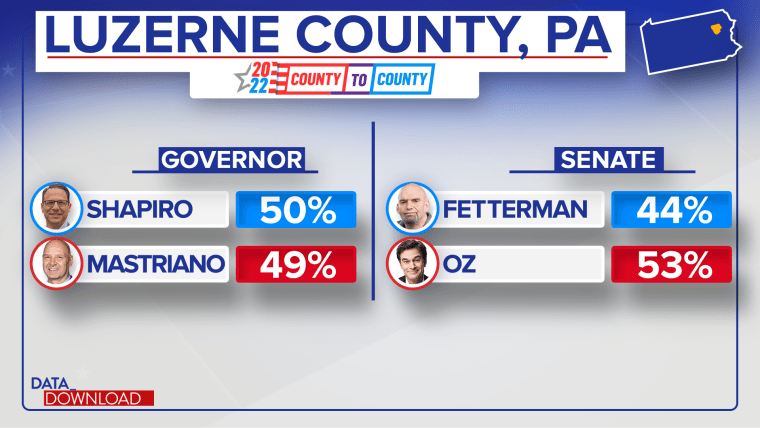Last week’s runoff win by Democratic Sen. Raphael Warnock in Georgia marked the official end of the 2022 midterm elections. And with that, the Data Download takes a look at what we learned from some of our County to County locales in this cycle.
Going into 2022, the NBC News team turned its focus to a set of counties to examine how different segments of the electorate — African American voters, evangelical voters, college town voters and different kinds of Republicans — would respond to the campaign. As we noted recently, the lessons varied depending on the state, but the County to County communities showed some revealing trends.
Anson County, North Carolina: African American voters
Along the southern border of North Carolina, Anson is a sparsely populated county where African Americans are about half the population. In 2020, Joe Biden carried the county by about 4 points on the strength of turnout among those voters. The question was whether they would turn out for the midterm election.

And the results certainly suggested that African Americans didn’t turn out as well in Anson. The county produced about 4,000 fewer votes in this year’s Senate race than it did in the 2020 presidential election — a drop of 36%. And Republican candidate Ted Budd “flipped” the vote coming out of Anson to win it on his way to winning the state.
The drop in turnout in Anson was mirrored in other communities with large African American populations, including big cities, such as Detroit, Milwaukee and Philadelphia. The decline among an important voter bloc for the Democrats is something the party is likely to be looking at as 2024 approaches.
Chattooga County, Georgia: Evangelical voters
Up in the top western corner of Georgia, Chattooga is a rural community where half the population identifies as white evangelical Christians, according to the 2020 American Religious Landscape survey from the Public Religion Research Institute. Chattooga and other counties like it were crucial to Donald Trump's presidential runs in 2016 and 2020; the question was how it would respond to the first post-Trump midterm.

In terms of margins, Chattooga came through for Republican Senate nominee Herschel Walker, who got 80% of the vote Tuesday. That was the same percentage Trump got in 2020. But a lower turnout probably hurt Walker. Chattooga produced 3,200 fewer votes than it did in the 2020 presidential race — about 32% fewer votes.
In close races, Republicans need to pump up turnout from small rural counties to help offset Democratic advantages in urban areas; that’s especially true for rural white evangelical communities in the South, where GOP margins are massive. Chattooga and other counties like it in Georgia didn’t produce enough without Trump on the ballot.
Dane County, Wisconsin: College town voters
Dane County, the home of Madison and the University of Wisconsin, has become increasingly important for Democrats as a reliable cache of blue votes. But college voters often don’t show up for midterms. Last month was a test of whether the party could get college students to the polls.

Dane turned out to be a big success for the Democrats. In the Senate race, the county produced 90% of the votes it produced in the 2020 presidential race. And Democrat Mandela Barnes basically got the same percentage of the vote Biden did in 2020: 77%. Barnes wound up narrowly losing to incumbent Ron Johnson in part because of poor turnout in Milwaukee.
The big turnout and margins in Dane were seen in other college town communities, as well, such as those in Michigan, where they propelled Democratic Gov. Gretchen Whitmer and helped pass an amendment to make abortion a right in the state’s constitution. The vote numbers suggest such communities may be more activated in future midterms, at least when races are close.
Delaware County, Ohio: Exurban Republican voters
Just north of Columbus, Delaware County is home to a particular brand of Republicanism — one that looks more like the Chamber of Commerce type of conservative who once dominated the GOP.
Ohio offered a particularly interesting test for the county, because there were two statewide Republican candidates who represented different aspects of the party: Gov. Mike DeWine, who made a point of not being a supporter of Trump, and Senate candidate J.D. Vance — who tied himself closely to Trump.

And the results showed the differences a candidate can make. DeWine won the county by about 28 points. Vance carried Delaware, as well, but by a much narrower 6 points. Vance still won Ohio, but the race was much closer.
There are exurbs across the country and in states where the vote is more evenly split between Democrats and Republicans; the GOP needs big margins in them. The numbers in Delaware suggest Trump could be a real drag on the Republican vote in those communities in 2024 if he gets the nomination.
Luzerne County, Pennsylvania: Blue-collar Republican voters
In northeastern Pennsylvania, near Scranton, Luzerne County is a blue-collar community that has been trending Republican, especially since Trump arrived on the political scene. Trump won it by about 14 points in 2020. The question was whether Trump’s voters would come out without Trump on the ballot. And the answer suggested again that candidates matter, but in a surprising way.

Republican gubernatorial candidate Doug Mastriano, who proudly tied himself to Trump and ran a Trump-like campaign attacking the media, lost Luzerne by about 1 point as he lost badly to Democrat Josh Shapiro statewide. Meanwhile, Republican Senate nominee Mehmet Oz, whom Trump hand-selected as the GOP nominee, won Luzerne by about 9 points, even as he lost the overall race.
The data out of Luzerne suggests that even among Trump-leaning voters, there may be candidates who can go too far, at least when Trump isn’t on the ballot. Luzerne should have been good territory for Mastriano. And the pattern was similar in the blue-collar suburbs of Michigan, where Republican gubernatorial nominee Tudor Dixon, an election-denying Trump supporter, lost in similar communities in the state.